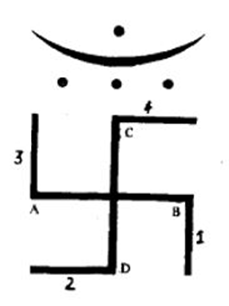CERTIFICATE OF INCORPORATION of the KEVALAJÑĀNAVINAYATĀPASYA-SAṄGHA
KEVALAJÑĀNAVINAYATĀPASYA-SAṄGHA THE UNIVERSAL JAIN SAṄGHA (RELIGIOUS COMMUNITY) [69 of 78]
APPENDIX VI [25 of 28]
18. JAINA SYMBOLISM [3 of 6]
TIME
The recognition of time as something that makes old new and new old. The soul not only goes into eternity, but also comes from eternity. Keep going in circles in the four gatis until we realize we have to perfect ourselves to get out of there. The symbol for this is the swastika

“…These two lines, A-B and C-D (the horizontal and vertical) without anything else would be the Greek cross. We add four other lines as represented in the illustration. Then we add three circles and the crescent, and a circle in the crescent; now the cross is complete. When expressed partially an idea is misinterpreted. I will give an example. There is a verse (among the Jainas) of two lines, the meaning of the second being connected with that of the first and these two lines must be interpreted together. The Brahmins, who had been at certain epochs in the history of India inimical to the Jainas, got hold of the second line only, which they interpreted to mean, “Even if a person is going to be killed by an elephant, he ought not to go into the Jaina temple.” The idea conveyed by the Brahmin interpreter is that the Jaina temple is so bad that one ought not to seek protection in it even if he is on the point of being killed by an elephant. If you take the first line with it then the whole meaning is changed. It is this: ‘When a person has killed an animal, or any living thing or has returned from an immoral house, or a vicious place, or if he has drunk wine, then he ought not to pollute the Jaina temple even if he is followed by an elephant.’ So, in the case of Swastika – if you take only the cross and side lines you cannot have the full meaning, while if the circles and crescent are added you have the whole before you. The idea is there are four grades of existence of souls in the material universe. The first is the lowest state. When the soul evolves from that state it comes to the next stage – the plant, the earth, the animal life which is lower than the human life, then evolves to the third stage, the human life. Then the fourth stage, the celestial. I use the word celestial to mean the life of other worlds than our own. All these graduations are combinations on different scales of matter and soul. The spiritual plane is that in which the soul is entirely freed from the bonds of matter. In order to reach that plane, you must strive to possess the three jewels (the circles): right belief, right knowledge, right conduct. When you get these, you are on the right path. Otherwise, there is not settled course for you: you are, as it were, tossed indiscriminately in a large river and do not know where you are going. If you have possession of the jewels, your basis is sure. When you have these three things, viz. right belief, right knowledge, right conduct, you will certainly go upwards higher and higher until you reach the state of liberation. That we represent by the crescent. Why? Because the crescent is the first form of the rising moon, it is the representation of a form which is going to grow larger and larger. When the soul has reached this stage, it is omniscient. When it has reached its full consciousness, its horizon becomes larger and larger. The interpretation, according to the Jaina view, of the cross has nothing to do with the combination of the male and female principles. Worship of the male and female principles – ideas based on sex, lowest even on the emotional plane, can never raise us higher than the male and the female.
We go to the temple every day in the morning, we make such symbols (Swastika) when we enter the temple. The object of doing this is that this sign must remind us of the great principle that in order to avoid the round of mundane existence one must have the three jewels and then reach the ultimate good. These symbols intensify our thoughts and make them more permanent.
The horizontal and perpendicular lines would represent spirit and matter.
The circle in the crescent represents the highest state (the state of liberation) the soul reaches; when it has full consciousness and lives apart from matter it is liberated.
I visited the Smithsonian Institution the other day and saw many of these crosses. It is called Swastika. That literally means a sign of good luck. Several of those I saw, Dr. Wilson told me, had been found in the Southern States. These signs are found made on pottery, and on articles of daily use. The idea is that people believe this sign will give them good luck. The implements they use to obtain their livelihood are indeed sources of power for them, and therefore the natural desire would be to put marks on them which, in their belief, would give them prosperity and health. In India they have this kind of a cross on their implements as a sign of good luck…”
Virchand R. Gandhi,[1] Religion and Philosophy of the Jainas, Lalit C. Shah, Ahmedabad 1993, pp. 88-92.
[next … → … https://www.om-arham.org/blog/view/13762/certificate-of-incorporation-of-the-kevalajnanavinayatapasya-sa%E1%B9%85gha]
[1] Virachand Raghavji Gandhi (25 August 1864 – 7 August 1901) was a Jain scholar who represented Jainism at the first World Parliament of Religions in 1893. For more details see https://en.wikipedia.org/wiki/Virchand_Gandhi.